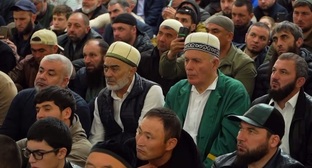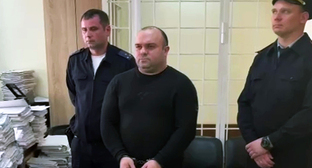10 January 2022, 14:36
Week in the Caucasus: review of main events of January 3-9, 2022
Celebration of Epiphany and Nativity of Christ; echo in the Caucasus of anti-government protests in Kazakhstan; evacuation of residents of Kuban because of flooding, – see the review of these and other events in the Caucasus during the week of January 3-9, 2022, prepared by the “Caucasian Knot”.
Celebration of Epiphany and Nativity of Christ
On January 5, parishioners of the Armenian Apostolic Church celebrated the eve of Epiphany and in the evening started to celebrate the holidays of Nativity of Christ and Baptism. After the festive liturgies, believers with lit candles and lamps went home for family festive feasts. The parishioners of the Armenian Apostolic Church called the Epiphany a family holiday. It combines the Nativity of Christ and the Baptism in itself. The holidays of Christmas and Baptism are jointly celebrated due to the fact that the Armenian Church did not participate in the Council of Chalcedon in 451, at which a decision was made to celebrate Christmas and Baptism separately.
On the night of January 7, Christmas services were held in most churches in the regions of Southern Russia where Orthodox parishioners live. The regional authorities took care of strengthening security measures and transporting believers after services. The coronavirus pandemic had little impact on Christmas plans. At the same time, some of the believers considered it unsafe to visit the temple during the pandemic. So, in Nalchik, some parishioners of the Church of St. Simeon Stylites chose to stay at home and prepare the festive table. They spoke about their fears of attending church because of the danger of contracting the coronavirus infection. In Volgograd, as the “Caucasian Knot” correspondent reported, Christmas services were held in violation of the coronavirus restrictions: many believers participated in services without masks and did not keep their distance, despite warnings about the mask regime.
Echo in Caucasus of anti-government protests in Kazakhstan
The aggravation of the political situation in Kazakhstan affected residents of Southern Russia and the countries of Southern Caucasus. Let us remind you that on January 2, residents of the cities of Zhanaozen and Aktau in the Mangistau Region of Kazakhstan massively took to the streets with an appeal to the authorities to reduce fuel prices. Later, the protests spread throughout the country. A state of emergency has been declared in Kazakhstan until January 19. The number of people detained as a result of the protests exceeded 4000. During the riots, 18 soldiers and policemen were killed, and among civilians an employee of the “Almaty” TV Channel died from a fatal gunshot wound. On January 6, Armenian Prime Minister Nikol Pashinyan, the chair of the Collective Security Council of the Collective Security Treaty Organization (CSTO), granted the request of Kassym-Jomart Tokayev, President of Kazakhstan, to bring the CSTO peacekeeping forces into the country. CSTO Secretary General Stanislav Zas announces that the CSTO peacekeeping forces in Kazakhstan will number about 2500 personnel from Russia, Belarus, Kyrgyzstan, Armenia, and Tajikistan.
On January 7, a rally in support of the Kazakh people took place in front of the parliament building in Georgia. Activists state that the introduction of CSTO troops into Kazakhstan because of the protests is unacceptable. On January 8, it was reported that Armenia had sent 100 soldiers to Kazakhstan. Users of the Armenian Facebook segment criticized Nikol Pashinyan for his content to send the military forces from Yerevan to Kazakhstan. Social media users note that such decisions were to be approved by the parliament. In their declaration, members of 20 human rights and public organizations of Armenia state that the introduction of the military forces into Kazakhstan will damage the international image of Armenia. Analysts from Baku suggest that the introduction of the CSTO troops into Kazakhstan will aggravate the political crisis in the country and increase the anti-Russian sentiments and the desire of society to withdraw from the CIS institutions. Against the background of the situation in Kazakhstan, politicians argue about the likelihood of such a scenario in Azerbaijan. According to the opposition, if the authorities of Azerbaijan do not carry out democratic reforms, the country may face mass protests such as those that took place in Kazakhstan. A spokesperson for the ruling party believes that no mass protest actions in Azerbaijan will take place due to the high confidence of the people in the president of the country.
On January 5, Chechen leader Ramzan Kadyrov reacted to the situation in Kazakhstan. The leader of Chechnya called on the protesters to stop their actions and compared the events of today with the situation that was followed by the introduction of federal troops into Chechnya. On January 6, Biysultan Khamzaev, a member of the State Duma from Dagestan, voiced a proposal to annex Kazakhstan to Russia. Facebook users considered the proposal as populism and called on the State Duma member to remove his posts so as not to disgrace natives of Dagestan.
Evacuation of Kuban residents because of flooding
On January 4, the Vulan River overflowed its banks and flooded about 70 yards in the village of Arkhipo-Osipovka near Gelendzhik. Sixteen people were evacuated and placed in accumulation and evacuation centres. Two persons were transported to hospital because of their poor health state, and other 14 were accommodated at a sanatorium. According to the press service for the Gelendzhik Mayor’s Office, the flooding was caused by a downpour, which raised the water level in the Vulan River. On the same day, the water level in the Vulan River dropped and residents evacuated from the flooded zone returned to their homes, the Ministry for Emergencies (MfE) reported. It should be noted that earlier, on January 2, residents of Anapa and Slavyansk-on-Kuban reported about flooding of their yards after prolonged rains. According to the authorities, the yards that were not equipped with storm drains were then flooded. The existing storm drains are not able to cope with water flows, and there is a risk of flooding of houses, local residents argue.
This article was originally published on the Russian page of 24/7 Internet agency ‘Caucasian Knot’ on January 10, 2022 at 09:50 am MSK. To access the full text of the article, click here.





Комментирование через Кавказский узел